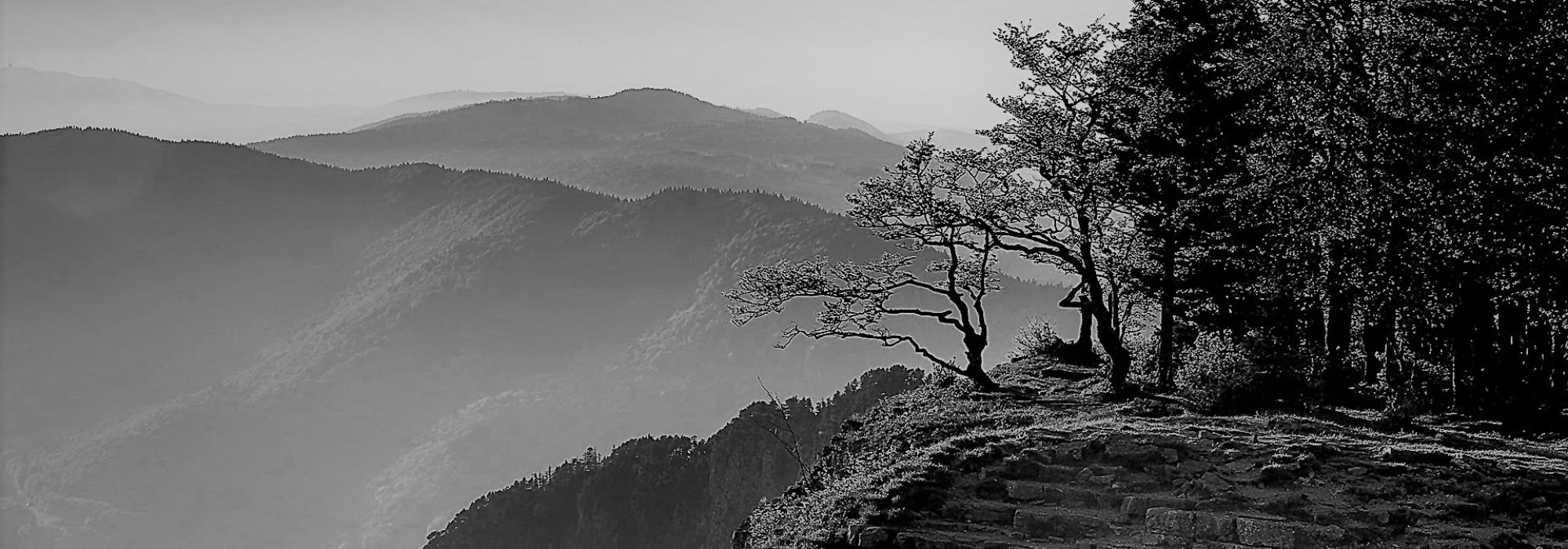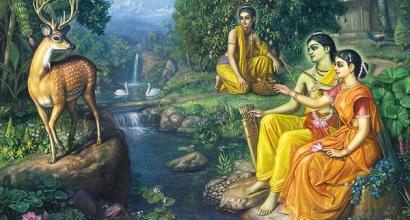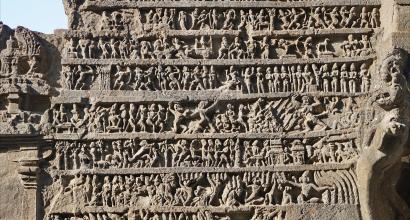The word abhinaya means to take things closer[1]. The word can also mean good character and making things one’s own. Abhinaya can be divided into four kinds, namely āṅgika, āhārya, vācika, and sāttvika. As the very name suggests, āṅgikābhinaya is to do with the movement of the major and minor parts of the body including hands, legs, waist, neck and head. These movements are supposed to add beauty to the art and also communicate emotions to the audience. Mukhajābhinaya, i.e., facial expressions come in addition to the movement of different parts of the body and helps in bolstering communication. Āṅgikābhinaya can also be called the movement vocabulary that is used to effectively translate the embedded meaning and emotion in the lyrics that comes as an accompaniment to theatre art. It is also a set of beautiful movements that can help depict episodes and establish different characters. Just as theatre art is enriched with music consisting of svara, tāla, laya and jati, āṅgikābhinaya too is beautiful, self-complete and communicative.
Just as classical music has elements such as tāna, svarakalpana and jati that work withing the frame work of tāla and laya, different aspects of āṅgikābhinaya may also be brought within a similar framework. For example, the nṛtta of Sadir and Tāphā, the fundamental footwork – hèjjè of Yakṣagāna and bhramarī of Kathak work in the framework of rhythmic patterns. Āṅgikābhinaya may go beyond the frame work of a tāla and work with an internal, implicit and suggestive rhythm without conforming to any particular rhythmic cycle. The sthānakas, cārīs, nṛtta-hastas, and karaṇas of the Nāṭyaśāstra are movements which belong to this category. The movements filled loka-dharmī as well as the precision and exalted imitation performed though abhinaya-hastas also don’t follow a strict cycle of tāla.
Nevertheless, it is nṛtta – pure, abstract, non-representational dance set to tāla and laya - that first comes to our mind at the mention of the term āṅgikābhinaya. This kind of association is not without reason either. Pure āṅgikābhinaya that does not have a narrative or a situational meaning is beautiful in itself and can be entertaining. It is almost inevitable to perform it to tāla and laya, especially to avoid it from becoming hazy and amorphous. This also helps it to be self-complete and uber-worldly. Āṅgikābhinaya of this kind has scope for using different parts of the body without being restrained to communicate a particular aspect only. Because of tāla and laya, movements naturally tend to become linear and the body is moved in symmetric patterns. One must not get the impression from the foregoing discussion that āṅgikābhinaya has to work within the framework of tāla and laya at all times (this has been clarified in the previous paragraph too). Many scholars and dancers even go to the extent of saying nṛttaṃ tāḻāśritam, i.e., nṛtta is always dependent on tāla. Most dancers, with hardly a few exceptions, indicate tāla and laya through their footwork and this has in turn give the illusion that nṛtta (and even āṅgikābhinaya!) is mere footwork. This limited understanding of nṛtta and the purpose of dance as a whole is rather worrisome. This misunderstanding of the ultimate purpose of dance seems to be more prevalent in regional forms of dance. Keeping track of complicated tāla cycles merely to bring in different tāla patterns certainly requires a great deal of intellectual acumen and is also more concrete than the expression of emotions, which are far subtler. These complex and arithmetic tāla patterns are usually expressed through footwork and it requires a fair bit of concertation on the part of the artist. However, footwork that keeps track of tāla patterns is certainly easier to master than holistic āṅgikābhinaya, which involves communicating ideas, emotions and episodes. In order to communicate emotions through the body, every part of the body should be trained and must be tuned to bring out subtleties. It requires a lot of mental involvement and co-ordination between different parts of the body in association with the mind. Quantifiable footwork is naturally easier to master than gaining expertise over qualitative and holistic āṅgikābhinaya. Footwork is quite mechanical, predictable and works in the material domain (as against being spiritual, i.e., associated with the spirit). Wholesome āṅgikābhinaya that is used to communicate emotions cannot be mechanical. The artist must get into the situation and the character to successfully perform such āṅgikābhinaya. Only this kind of abhinaya can help the connoisseur dissolve and forget himself in Rasānubhava. This is, in fact, one of the primary differences between mārga and deśī. The mārga of the Nāṭyaśāstra defines the karaṇas and aṅgahāras more for wholesome communication through the body and not merely for displaying rhythmic patterns through footwork. They are meant for enriching sequences filled with emotional exuberance in a dance or theatre performance.
Sadir, Kathak, and other regional dance forms of India emphasise tāla and laya to such an extent that people have developed a misconception that āṅgikābhinaya is just nṛtta. There are artistes and connoisseurs today who use tāla as the primary yardstick to evaluate the worth of an art! Needless to say, adherence to tāla and the footwork of the dancer are important elements of dance and are beautiful to an extent, but holistic āṅgikābhinaya involving all aṅgas and upāṅga, filled with recakas is much more important. The latter should have a predominant place in any form of dance (or theatre art) and the former should be subservient to the latter. Rhythmic footwork should only like the service a servant does to his master and not dominate over the master. Recaka is the very soul of āṅgikābhinaya in dance, just as gamaka is to Indian classical music. It is important for artists of Yakṣagāna to keep this in mind. When rhythmic footwork set to arithmetic patterns dominates, there is hardly any scope for bringing in recakas. Such dominance removes beauty from dance and decreases its potential to please the audience. Yet, some people who look at an art form only at its gross level and lack eye of subtilities might have the tendency to say that such performances also qualify as great art.
The aesthetic principles discussed in the previous paragraph are applicable to Yakṣagāna as well. Perhaps it was only Dr. Shivaram Karanth who stressed on the importance of holistic āṅgikābhinaya over and above mere hèjjègārike – footwork in Yakṣagāna. He laid stress at a time when the other practitioners of the art had paid little attention emotive expression of the entire body. Even today the Yakṣagāna audience and critics seem to be more interested in footwork. Neither the artistes nor the reviewers give much importance to wholesome āṅgikābhinaya. While Karanth’s efforts need to be hailed, we will also need to keep in mind that he largely tried to override hèjjègārikè that’s purely tāla-based but did not try to make tāla subservient to Yakṣagāna. In other words, he did not attempt to transcend tāla. It is probably because of this approach that his efforts did not translate into bringing out beauty at all levels of āṅgikābhinaya. Moreover, instead of viewing Yakṣagāna from the perspective of Nāṭyaśāstra and the traditional Indian theatre in practise, Karanth tried to view it from the perspective of the Western ballet. This is probably the reason for Karanth’s attempts not resulting in wholesome and holistic āṅgikābhinaya. Shambhu Hegade put efforts in this direction as well but he did not seem to be successful in grasping the principles of āṅgikābhinaya underlying pan-Indian theatrical forms.
The āṅgikābhinaya of Baḍagutiṭṭu can be seen as two major variants - the harāḍi and the maṭapāḍi along with that of Uttara Kannada. These styles have their own impressive features but have hèjjègārikè dominating over them. The artistes who follow either of the two styles bring in āṅgikābhinaya as per their capacities, creativity and erudition. Though this brings in variety, the differences are largely relative to the artiste. Similar is the case with the Uttara Kannada style. Though it has a flavour of its own, it is again a function of individual strengths and capabilities. I have witnessed the āṅgika of Bannanje Sanjeeva Suvarna, Shambhu Hegade, Cittani Ramachandra Hegade, Kodadakuli Ramachandra Hegade, and Mantap Prabhakar Upadhya among others. Keeping the āṅgika of these artists in mind and the seminar that Dr. Padma Subrahmanyam conducted on mārga-nṛtya in the backdrop, I shall go ahead with the rest of my analysis.
This series of articles are authored by Shatavadhani Dr. R Ganesh and have been rendered into English with additional material and footnotes by Arjun Bharadwaj. The article first appeared in the anthology Prekṣaṇīyaṃ, published by the Prekshaa Pratishtana in Feburary 2020.
[1] The ṇīñ-prāpaṇe dhātu when prefixed with the upasarga abhi and comes along with the ac pratyaya, the word abhinaya comes into existence














































